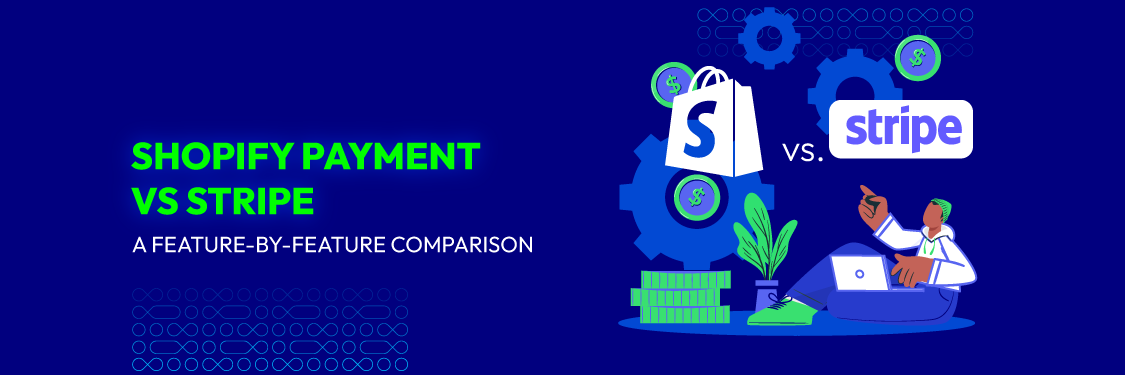Shopify Payment Vs Stripe: A Feature-by-Feature Comparison
Summer Nguyen | 05-21-2024

Selecting the correct payment processor is vital for eCommerce success. Two widely discussed options are Shopify Payment vs Stripe. Both platforms provide various features, but which is better for you?
This guide compares Shopify Payment vs Stripe to aid your decision. We’ll examine their features, advantages, and disadvantages for informed choices.
About Shopify payment and Stripe
Shopify Payment simplifies online payments for Shopify store owners. It is directly integrated into the Shopify platform. This ensures the tool works independently without problems. Merchants can easily manage payments and many other tasks such as inventory and orders.
Customers can pay with major cards or alternative methods. This helps enhance the payment experience. The platform has security measures that protect customer data and competitive fees to suit any budget. Shopify Payment simplifies the payment process for seamless online sales.
Stripe supports a variety of online payments. Portals are seamlessly integrated within websites and applications. Business owners efficiently handle payments along with inventory and order management.
Customers enjoy diverse payment options, enriching the checkout experience. Robust security protocols safeguard customer information, with flexible pricing options. Stripe optimizes payment procedures, ensuring seamless and stress-free transactions.
Shopify Payment Vs Stripe: Quick assessment
Compare Shopify Payments and Stripe. Choose the best for online payments.
Shopify Payments:
- Integrated payment system for Shopify stores.
- Seamless checkout process for Shopify users.
- Ensures secure transactions and easy setup.
- Designed for businesses selling on Shopify.
Stripe:
- Versatile payment service for various platforms.
- Customizable payment options for businesses.
- Supports global transactions and multiple currencies.
- Good for any business size, not just Shopify users.
- Take a closer look at Shopify Payments and Stripe to find your best one.
| Factor | Shopify Payment | Stripe |
| Pricing | A percentage fee and a fixed amount per transaction | A customizable pricing structure |
| Security and Compliance | Adhering to PCI standards to protect and comply with industry regulations | Uses encryption and fraud detection algorithms |
| Ease of Use | Simplicity within the Shopify ecosystem | More customization or operation outside of Shopify |
| Availability | Integrated with Shopify and available to Shopify users only | Supports merchants in 46 countries |
| Flexibility | Integrates seamlessly with the Shopify platform | A range of customizable payment tools |
| In-Person Payments | Primarily caters to online transactions | Offers in-person payments via its POS platform terminal |
| Support and Documentation | Focuses more on simplicity and user-friendly resources | Provides in-depth technical documentation for customization and integration |
Shopify Payment Vs Stripe: Detailed comparison

Pricing plan
Comparing Shopify Payments and Stripe fees reveals differences in payment processing.
Shopify Payments:
- Transaction fees based on plans.
- Basic plan charges 2.9% plus 30 cents for online card payments.
- Advanced plan charges 2.4% plus 30 cents for online card payments.
- No setup or monthly fees.
- Additional 2% fee for other gateways.
Stripe:
- Transaction fees vary by location and method.
- In the US: 2.9% + 30¢ for online credit card payments.
- No setup or monthly fees.
- Charges for chargebacks, currency conversions, or specific methods may apply.
So, understanding fee structures helps choose the right platform. Analyze transaction fees, extra charges, processing times, and integration fees. Then, pick the platform that suits your business needs and budget.
Read more: SHOPIFY PAYMENTS: EVERYTHING YOU NEED TO KNOW
Settlement Period
When comparing Shopify Payments and Stripe, consider several factors regarding how quickly you get your money. Shopify Payments usually deposits funds within 2-3 business days, ensuring quick access and steady cash flow.
Stripe offers more flexibility in payout frequencies, including daily, weekly, or monthly options and instant payouts for an additional fee. It’s important to check for any hold periods that may delay fund availability, as both platforms may impose them, especially for new or high-risk accounts or flagged transactions.
The conclusion is to think about how urgently you need money. How do you handle your finances? Are you willing to pay more to get paid immediately? Then, you will decide what to choose.
Security and Compliance
Stripe is known for its strong security features. It lets businesses customize security controls and tools to protect sensitive data. Businesses can adjust security measures to fit their needs.
Meanwhile, Shopify Payments isn’t as flexible as Stripe but emphasizes security. It offers basic security features and follows compliance rules.
In summary, Stripe gives businesses lots of options for security and customization. Shopify Payments is simpler, but still secure for Shopify stores.
Customization Options
Stripe allows you to customize your online payments easily. You can customize your payment process, subscriptions, and buttons. It’s especially good for developers and can easily adjust to your business needs.
On the other hand, using Shopify Payments is more convenient. Because it is available in your store. However, you cannot make many adjustments. You can only make basic changes in the Shopify admin panel, not complex ones.
Integration
Shopify Payment is smooth with various online store platforms for easy setup. Check compatibility with accounting and inventory software for better management. Integration with email tools like Mailchimp allows targeted messaging. Selling on social media expands your reach to potential customers. Developer tools enable custom features and connections with other systems.
About Stripe, it integrates seamlessly with online store platforms for easy setup. Confirm compatibility with accounting and inventory software for better management. Integration with email tools like Mailchimp allows targeted messaging. Selling on social media broadens reach to potential customers. Developer tools enable custom features and connections with other systems.
Based on the comparison, Shopify Payments is a good choice for connecting with other tools. Especially if you’re already using Shopify.
Payment Methods
Shopify Payment and Stripe accept many payment methods, from Credit/debit cards, digital wallets, and bank transfers. Both platforms can connect with popular payment gateways. Making it easy to process payments.

Shopify Payment is integrated into Shopify. While Stripe offers compatibility with many other payment gateways. Fees for Shopify Payment and Stripe are based on transaction volume. And may include additional charges for international transactions or currency conversions.
Choosing depends on your business’s payment needs. Also processing preferences, and international sales volume.
Read more: B2B ECOMMERCE PAYMENT METHODS GUIDE: COMPARE PROS & CONS IN 2024
In-Person Payments
Shopify Payments accepts in-person payments easily with Shopify. Manage both online and offline sales together. Use Shopify’s POS hardware or your smartphone for transactions. Convenient and straightforward for Shopify users.
On the other hand, Stripe takes in-person payments with Stripe’s Terminal service. Choose from various hardware options like card readers and terminals. Requires more setup but offers flexibility and scalability. Ideal for businesses with complex needs or using multiple platforms.
Platform’s policy and support
Deciding which platform is better for policy and support, Shopify Payments or Stripe. It depends on what your business needs.
Shopify Payments has its own policies and support system. It provides guidelines for using its payment platform. You can rely on Shopify’s customer support for help with any payment issues.
Similarly, Stripe has its own policies and support resources. They offer guidance on using their payment services. You can reach out to Stripe’s support team for assistance with payment-related matters.
Easy to use
When comparing the ease of use between Shopify Payments and Stripe, consider several factors.
- Shopify Payments aims to simplify setup for beginners and small businesses. It’s easy to start with minimal hassle. Navigation in Shopify Payments is straightforward, making it easy for users to find what they need quickly. Shopify streamlines the transaction process, allowing direct payment processing within the Shopify store. Support is available for users who need assistance, ensuring a smooth experience.
- Stripe offers more customization but may require technical know-how. Stripe provides users with a user-friendly dashboard for managing payments. Integration with e-commerce platforms is seamless, ensuring that payment processes sync easily. While Stripe offers more flexibility, it may require more setup time. Support is available for users, but accessibility features are essential for all users.
Analytics and Reporting
When it comes to analyzing your business data, both Shopify Payments and Stripe have good tools.
- Shopify Payments works well with Shopify’s online store, giving you lots of info on sales, customers, and transactions.
- Stripe offers even more detailed analysis and lets you customize reports more. It’s best to pick the one that fits your business needs. And it is the easiest for you to use.
When looking at Shopify Payments and Stripe, think about how their analytics and reporting work. Check if you can see how well your sales are doing, what types of transactions are happening, and how customers behave.
Look for tools that let you change reports and view data in ways that are useful to your business. Make sure the information is easy to find and understand for you. Additionally, you can look at other tools like accounting or inventory software. Finally, look for additional features like sales forecasting or viewing customer groups for more insights.
User Feedback
Comparing user feedback between Shopify Payments and Stripe shows some differences. People like Shopify Payments because it’s easy to use, especially if they already use Shopify. It’s simple for customers to set up and integrate with their online store.
On the other hand, customers like Stripe for its flexibility and customization options. Users can adjust their payment processes to better suit their needs. Stripe is also popular for its features that developers find helpful.
Both platforms generally get good feedback for being reliable and for the payment experience, but if you want something easy and integrated, Shopify Payments might be better. If you prefer more control and customization, Stripe could be the way to go.
Pros and Cons of Shopify Payment Vs Stripe
| Pros and cons | Shopify Payment | Stripe |
| Pros |
|
|
| Cons |
|
|
Understanding their strengths is crucial. Knowing how they fit your needs is also essential. This comparison helps in making an informed decision about which platform to choose.
Shopify Payments:
- Easily works with the Shopify platform.
- Simple for beginners and those not tech-savvy.
- Includes payment and shipping features, great for new businesses.
- Can grow with your business.
Stripe:
- Flexible, customizable payment options.
- Popular with developers and tech-savvy businesses.
- Strong fraud protection and many payment choices.
- For those wanting more control over payments.
In short, Shopify Payments is straightforward for businesses integrating payment on their website. Stripe suits those wanting more customization, especially tech-savvy users.
Wrap up
Both Shopify Payments and Stripe have their strengths. On one side, Shopify Payments is easy to use with Shopify. And it is suitable for beginners. While Stripe offers more customization options, providing greater control. Your choice depends on your business requirements.






![Top 20+ Must-have Shopify Apps for 2025 [Free & Paid] - Mageplaza](https://cdn2.mageplaza.com/media/blog/must-have-shopify-apps/top-must-have-shopify-apps.png)
![[2025 Updates] Top 10+ Upsell Apps for Shopify - Mageplaza](https://cdn2.mageplaza.com/media/blog/best-upsell-shopify-app/cover.png)